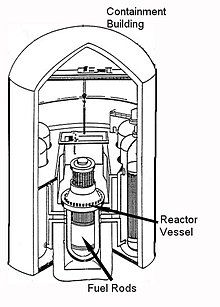 Global Information
Global InformationContainment building information


A containment building is a reinforced steel, concrete or lead structure enclosing a nuclear reactor. It is designed, in any emergency, to contain the escape of radioactive steam or gas to a maximum pressure in the range of 275 to 550 kPa (40 to 80 psi) [citation needed]. The containment is the fourth and final barrier to radioactive release (part of a nuclear reactor's defence in depth strategy), the first being the fuel ceramic itself, the second being the metal fuel cladding tubes, the third being the reactor vessel and coolant system.[2]
Each nuclear plant in the United States is designed to withstand certain conditions which are spelled out as "Design Basis Accidents" in the Final Safety Analysis Report (FSAR). The FSAR is available for public viewing, usually at a public library near the nuclear plant.
The containment building itself is typically an airtight steel structure enclosing the reactor normally sealed off from the outside atmosphere. The steel is either free-standing or attached to the concrete missile shield. In the United States, the design and thickness of the containment and the missile shield are governed by federal regulations (10 CFR 50.55a), and must be strong enough to withstand the impact of a fully loaded passenger airliner without rupture.[3]
While the containment plays a critical role in the most severe nuclear reactor accidents, it is only designed to contain or condense steam in the short term (for large break accidents) and long term heat removal still must be provided by other systems. In the Three Mile Island accident the containment pressure boundary was maintained, but due to insufficient cooling, some time after the accident, radioactive gas was intentionally released from containment by operators to prevent over pressurization.[4] This, combined with further failures, caused the release of up to 13 million curies of radioactive gas to atmosphere during the accident.[5]
While the Fukushima Daiichi plant had operated safely since 1971, an earthquake and tsunami well beyond the design basis resulted in failure of AC power, backup generators and batteries which defeated all safety systems. These systems were necessary to keep the fuel cool after the reactor had been shut down. This resulted in partial or complete meltdown of fuel rods, damage to fuel storage pools and buildings, release of radioactive debris to surrounding area, air and sea, and resorting to the expedient use of fire engines and concrete pumps to deliver cooling water to spent fuel pools and containment. During the incident, pressure within the containments of reactors 1-3 rose to exceed design limits, which despite attempts to reduce pressure by venting radioactive gases, resulted in breach of containment. Hydrogen leaking from the containment mixed with air, resulted in explosions in units 1, 3 and 4, complicating attempts to stabilize the reactors.
- ^ Martin Fackler (1 June 2011). "Report Finds Japan Underestimated Tsunami Danger". New York Times.
- ^ Nuclear Plant Security Systems, PDH Course E182
- ^ "§ 50.150 Aircraft impact assessment".
- ^ [U.S. Nuclear Regulatory Commission Fact Sheet on the Accident at Three Mile Island. http://www.nrc.gov/reading-rm/doc-collections/fact-sheets/3mile-isle.html]
- ^ [Report of The President's Commission on the Accident at Three Mile Island. http://www.threemileisland.org/downloads/188.pdf Archived 2011-04-09 at the Wayback Machine]